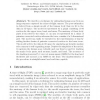Free Online Productivity Tools
i2Speak
i2Symbol
i2OCR
iTex2Img
iWeb2Print
iWeb2Shot
i2Type
iPdf2Split
iPdf2Merge
i2Bopomofo
i2Arabic
i2Style
i2Image
i2PDF
iLatex2Rtf
Sci2ools
DAGM
2009
Springer
2009
Springer
Self-Organizing Maps for Pose Estimation with a Time-of-Flight Camera
We describe a technique for estimating human pose from an image sequence captured by a time-of-flight camera. The pose estimation is derived from a simple model of the human body that we fit to the data in 3D space. The model is represented by a graph consisting of 44 vertices for the upper torso, head, and arms. The anatomy of these body parts is encoded by the edges, i.e. an arm is represented by a chain of pairwise connected vertices whereas the torso consists of a 2-dimensional grid. The model can easily be extended to the representation of legs by adding further chains of pairwise connected vertices to the lower torso. The model is fit to the data in 3D space by employing an iterative update rule common to self-organizing maps. Despite the simplicity of the model, it captures the human pose robustly and can thus be used for tracking the major body parts, such as arms, hands, and head. The accuracy of the tracking is around 5–6 cm root mean square (RMS) for the head and should...
Related Content
| Added | 26 May 2010 |
| Updated | 26 May 2010 |
| Type | Conference |
| Year | 2009 |
| Where | DAGM |
| Authors | Martin Haker, Martin Böhme, Thomas Martinetz, Erhardt Barth |
Comments (0)

